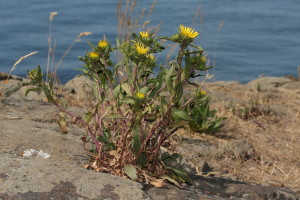Grindelia (gumweed) is a genus of plants native to the Americas belonging to the sunflower family.
Contents
Uses
A phenolic compound derived from the resin of Guaiacum trees is used in a common test for blood in human stool samples. The presence of heme in the blood causes the formation of a coloured product in the presence of hydrogen peroxide. The effect of peroxidases in horseradish on guiacum was first noted in 1810 by Planche.
As a food additive Guaiacum has the E number of E314 and is classified as an antioxidant.
A widely used derivative drug is the expectorant known as guaifenesin.
The soap fragrance oil of guaiac comes from Bulnesia sarmientoi, a South American tree from the same family.
Members of the genus are grown in Florida and California as ornamental plants.
Benefits
The remedy made from grindelia is considered to be valuable in dealing with cases of bronchial asthma. It is also effective in treating respiratory impediments caused by phlegm induced obstruction in the airways. The grindelia is considered to posses strong anti-spasmodic as well as expectorant actions. The remedy made from the grindelia brings a relaxing effect on the muscles lining the smaller bronchial passages and helps in clearing congesting mucus in the respiratory passages on the pulmonary system. The herbal grindelia remedy is also additionally believed to desensitize the nerve endings found in the bronchial tree and in helping slow the heart beat rate – this action leads to easier breathing for the affected individual. Remedies made from the grindelia are also used in treating chronic bronchitis and disorders like emphysema. The herbal remedy effectively clears up the accumulated mucus in the throat and the nose of the person affected by respiratory illness. Problems and disorders such as whooping cough, hay fever, and cystitis have also been treated using the grindelia remedy. The speed of healing in the skin following physical irritation and burns is also boosted by topical application of a poultice made from the grindelia herb.
The use of the grindelia herb can produce some side effects, which is the reason for it being contraindicated for some patients affected by specific disorders in the kidney or the heart. Different parts of the grindelia plant have different properties, dried leaves and the flowering tops possess anti-spasmodic as well as anti-asthmatic effects. The compounds present in these parts of the herb also induce an anti-inflammatory action, as well as being expectorant and sedative in action. Grindelia is primarily used as a herbal treatment for bronchial catarrh, particularly if there is an asthmatic tendency evident in the person. Grindelia based active compounds are excreted via the kidneys, a side effect is that this excretion can at times induce signs of renal irritation in the person using the herb. The grindelia is also used as a topical remedy for the treatment of many disorders, including the treatment of burns, the treatment of poison ivy rash, the treatment of disorders such as dermatitis, eczema and a variety of skin eruptions. Harvesting of the grindelia plant is usually carried out when the entire crop is in full bloom during the summer months. The herb can be used fresh ground into an herbal poultice for topical problems. The dried herb is also used for preparing herbal infusions, tincture and other remedies. The leaves and the flowering stems of the grindelia are the parts used in the preparation of the homeopathic remedy.
Cautions
None are recorded. Please consult with your doctor!
Interactions
Not enough information
Other names
Gumweed
References
Source: Wikipedia, https://en.wikipedia.org/wiki/Grindelia
Herbs, http://www.herbs2000.com/herbs/herbs_grindelia.htm

